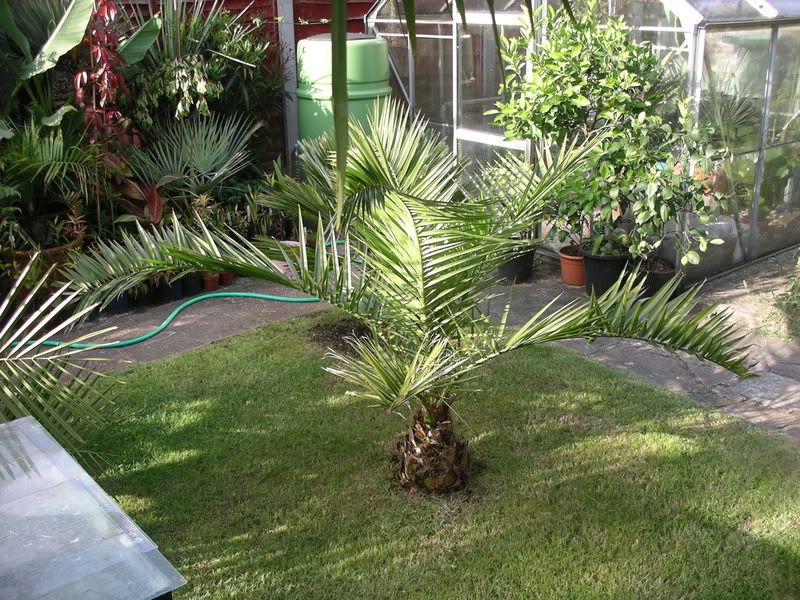Phoenix canariensis - numpty question
-
Alexander
I have 2 small Phoenix canariensis here on my allotment. I got them fromsomeone who had discarded them. They are planted on a sunny spot on well drained sandy soil. Qieut a lot off exotic growers have this palm in their garden here in the Lowcountries and Belgium. Its not a plam I would spend anny mony on because I guess one serious winter and they will all be gone, except those with a warmingcable and a shelter.
In Florence I know an old one on the rightbank of the Arno in Florence. It grows in a very shelteterd south facing garden. It has survived the minus 20 centigrades of 1985. I guess in warmer climates a lot of palms can take more cold then in climates with cool short summers.
See also that article in Palmtalks about Brahea in Florence and the extreme cold thay had there.
For a good hardy palm with feathery leaves I guess still Butia eriospatha is the best option and maybe the only one to spend (a lot of) money on.
Regards,
Alexander
In Florence I know an old one on the rightbank of the Arno in Florence. It grows in a very shelteterd south facing garden. It has survived the minus 20 centigrades of 1985. I guess in warmer climates a lot of palms can take more cold then in climates with cool short summers.
See also that article in Palmtalks about Brahea in Florence and the extreme cold thay had there.
For a good hardy palm with feathery leaves I guess still Butia eriospatha is the best option and maybe the only one to spend (a lot of) money on.
Regards,
Alexander
- Las Palmas Norte
- Posts: 1892
- Joined: Sun Oct 28, 2007 7:17 pm
- Location: Lantzville, British Columbia (Vancouver Island)
-
Richard
I'm not sure what's happened with those photo's Barrie. They were viewable last night 
I'll try to post them again with an example of the protection used. Although, oddly enough there's examples of Phoenix canariensis_CIDP's and Washingtonia in peoples gardens here completely unprotected for as long as I can remember. At their current cost, there's no reason not to give them go?
I'll try to post them again with an example of the protection used. Although, oddly enough there's examples of Phoenix canariensis_CIDP's and Washingtonia in peoples gardens here completely unprotected for as long as I can remember. At their current cost, there's no reason not to give them go?
-
Gaz
- Dave Brown
- Site Admin
- Posts: 19742
- Joined: Sun Jul 09, 2006 10:17 am
- Location: Chalk, (Thames Estuary) Kent, England 51.5N 0.3E
- Contact:
Richard,
The difference in your CIDs is probably due to hybridisation, as even in the Canaries now (home of Phoenix canariensis_CIDP) there are so many other Phoenix palms planted, it is only a matter of time before all seed will not be pure.
I had one which had the appearance of a refined green dactylifera, but unfortunately, it was not as hardy as other Phoenix canariensis_CIDP and sucummed to about -4C.
The difference in your CIDs is probably due to hybridisation, as even in the Canaries now (home of Phoenix canariensis_CIDP) there are so many other Phoenix palms planted, it is only a matter of time before all seed will not be pure.
I had one which had the appearance of a refined green dactylifera, but unfortunately, it was not as hardy as other Phoenix canariensis_CIDP and sucummed to about -4C.
Best regards
Dave
_________________________________________________
Roll on summer.....
http://www.hardytropicals.co.uk
Dave
_________________________________________________
Roll on summer.....
http://www.hardytropicals.co.uk
-
DavidF
And therein lies the dilemma (for me anyway).At their current cost, there's no reason not to give them go?
Every time I dig up or just bin, in the case of potted ones, a fried stump of tatty leaves I swear I won't bother with them again.
And then in the Spring they start appearing everywhere at really good prices and I think "Just one more go"
-
Richard
I've often considered the issue of hybridisation with respect to commercially grown CID's. You only have to drive through the country side of Morocco to see the amount of variation in date palms, which are apparently hybridised, self set plants. My understanding is that Dactylifera, as a commercial crop producing plant is actually imported into North Africa from the Middle East. Therefore, we have variation within Dactylifera combined with imported Phoenix canariensis_CIDP's, Reclinata and Robelenii. The question being, are the B&Q Phoenix canariensis_CIDP's specifically engineered to grow into slender, leggy, fast growing palms optimised for force growth in Holland. I thought my slender plant would eventually grow into a stocky 'British' looking plant, although sadly not. It's certainly less hardy than the stouter ones.
Is any body else having success with Phoenix varietal palms outside of the south coast?
Is any body else having success with Phoenix varietal palms outside of the south coast?
- Dave Brown
- Site Admin
- Posts: 19742
- Joined: Sun Jul 09, 2006 10:17 am
- Location: Chalk, (Thames Estuary) Kent, England 51.5N 0.3E
- Contact:
I'm in North Kent on the Thames, and I know Paul Spracklin has a couple of largeish ones in South Essex 
Best regards
Dave
_________________________________________________
Roll on summer.....
http://www.hardytropicals.co.uk
Dave
_________________________________________________
Roll on summer.....
http://www.hardytropicals.co.uk
-
Eddy
Re: Phoenix canariensis - numpty question
Sorry guys for using this thread for another question. How close to the house can I plant a phoenix palm?I am aware that I may not be around when it is big enough to harm the footings but it would be sad if one day, someone has to chop it down. I am thinking of putting one in the front garden some time in the future. Cheers Guys.(and Gals).
-
Gaz
Re: Phoenix canariensis - numpty question
Personally I would keep it at least 3 meters away. And even that might be too close.
The small ones that you can get are difficult to keep alive unless planted in pots and then moved for winter.
The small ones that you can get are difficult to keep alive unless planted in pots and then moved for winter.
- Dave Brown
- Site Admin
- Posts: 19742
- Joined: Sun Jul 09, 2006 10:17 am
- Location: Chalk, (Thames Estuary) Kent, England 51.5N 0.3E
- Contact:
Re: Phoenix canariensis - numpty question
Scrim,
I,ve put these on here before somewhere
This is one of the Southsea palms in 1996

The same palm 11 years later

I would not plant any closer than 3 feet from a wall to allow for the trunk, and 20 feet if you don't want the leaves touching the wall
I,ve put these on here before somewhere
This is one of the Southsea palms in 1996

The same palm 11 years later

I would not plant any closer than 3 feet from a wall to allow for the trunk, and 20 feet if you don't want the leaves touching the wall
Best regards
Dave
_________________________________________________
Roll on summer.....
http://www.hardytropicals.co.uk
Dave
_________________________________________________
Roll on summer.....
http://www.hardytropicals.co.uk
-
Daniel
Re: Phoenix canariensis - numpty question
For many years I ended up with brown crispy Phoenix Canariensis, they survive and come back strongly once they are a reasonable size. But...... I decided that it is worth the effort to protect them at anything below -4c. There is nothing worse than staring at a brown Phoenix all Spring and Summer, for it just to start looking good in September. They also grow so much faster in the Spring if they haven't suffered setback during the Winter.
I have an 8ft Summer pagoda over my main one this Winter and even put an electric heater inside at anything below -2c. The others that are not in the main view are left to fend for themselves. They are more sheltered with overhanging trees above them that seems to make quite a difference.
I am in the process of growing Bamboos, Acacias and Eucalyptus to provide overhead protection where possible. As I see this as the only long term solution to help them survive a bad Winter scenario.
If you live an area that never sees -4c or below then all of the above is irrelevant.
I have an 8ft Summer pagoda over my main one this Winter and even put an electric heater inside at anything below -2c. The others that are not in the main view are left to fend for themselves. They are more sheltered with overhanging trees above them that seems to make quite a difference.
I am in the process of growing Bamboos, Acacias and Eucalyptus to provide overhead protection where possible. As I see this as the only long term solution to help them survive a bad Winter scenario.
If you live an area that never sees -4c or below then all of the above is irrelevant.
Re: Phoenix canariensis - numpty question
Ade there is always one that does. This one was 6 foot when it was planted out about 4 years ago and has made a come back every year since then after being defoliated each winter. It was purchased as a little seedling from the Palm Centre in April 1997 and cost £3.95Ade said : Several of us tried the timaru CID a few years back, no more hardy than normal CIDs at a smallish size, dont recall any surviving.

-
photonbucket
Re: Phoenix canariensis - numpty question
My small Phoenix canariensis_CIDP made it through the mild winter of 2006-2007 without any damage. OK it was pretty mild but I didn't realise just how tender they where. I thought anything above -6c was definately ok. I cannot believe Ade protects that huge one! I'm going to tie up the fronds of my medium sized one if it gets cold.
The comment Ade made about not knowing the damage until spring has worried me!
So thanks for asking a "numpty" question; it taught this numpty something.
A theory: If the palm has a decent spell of growth during the summer, I guess the fresh fronds surround and therefore protect the central spear. My Phoenix canariensis_CIDP was only planted this year so it has sulked a little and the central spear is very exposed.
The comment Ade made about not knowing the damage until spring has worried me!
So thanks for asking a "numpty" question; it taught this numpty something.
A theory: If the palm has a decent spell of growth during the summer, I guess the fresh fronds surround and therefore protect the central spear. My Phoenix canariensis_CIDP was only planted this year so it has sulked a little and the central spear is very exposed.
